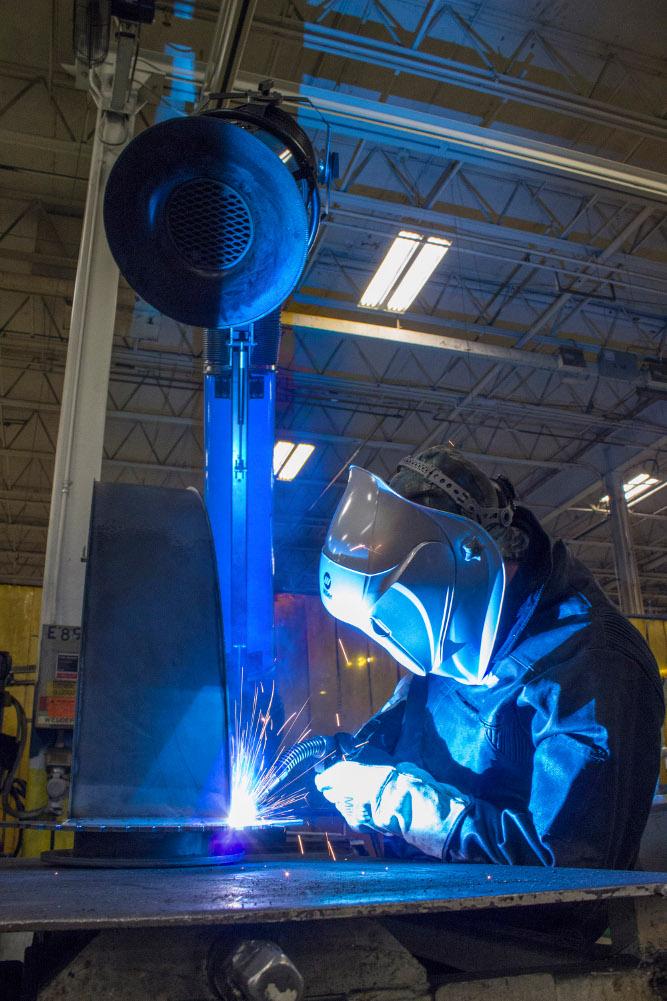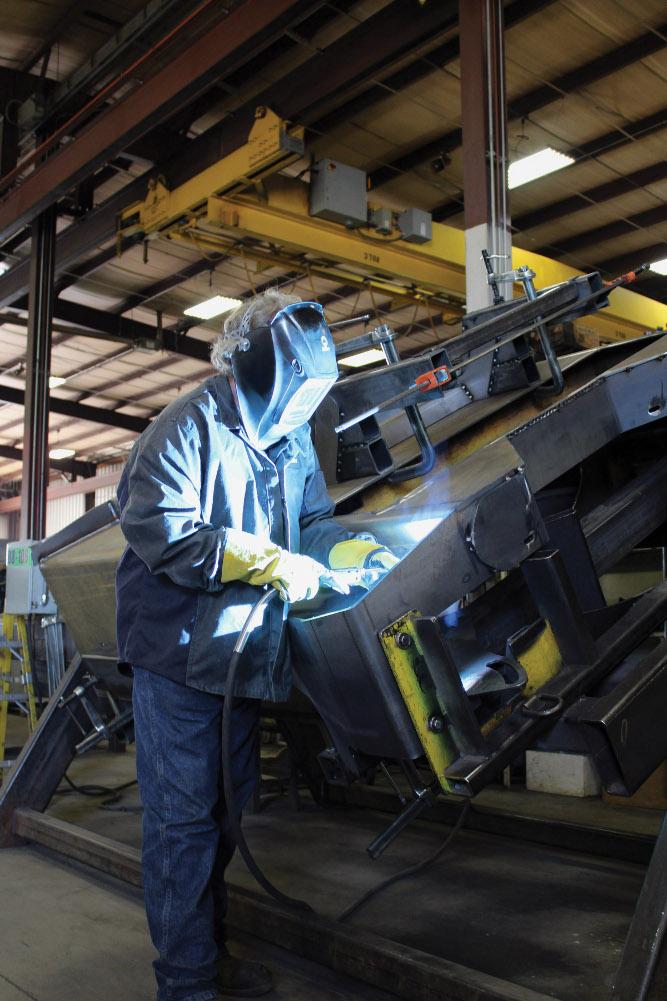- FMA
- The Fabricator
- FABTECH
- Canadian Metalworking
Categories
- Additive Manufacturing
- Aluminum Welding
- Arc Welding
- Assembly and Joining
- Automation and Robotics
- Bending and Forming
- Consumables
- Cutting and Weld Prep
- Electric Vehicles
- En Español
- Finishing
- Hydroforming
- Laser Cutting
- Laser Welding
- Machining
- Manufacturing Software
- Materials Handling
- Metals/Materials
- Oxyfuel Cutting
- Plasma Cutting
- Power Tools
- Punching and Other Holemaking
- Roll Forming
- Safety
- Sawing
- Shearing
- Shop Management
- Testing and Measuring
- Tube and Pipe Fabrication
- Tube and Pipe Production
- Waterjet Cutting
Industry Directory
Webcasts
Podcasts
FAB 40
Advertise
Subscribe
Account Login
Search
Weld process advancements
The latest in GMAW-P
- By Dave Almy and Ed Crum
- September 7, 2016
- Article
- Arc Welding

Many companies today are turning to advanced welding processes to help increase plant capacity — often with less labor — and expand their capabilities.
As the manufacturing and fabrication industries evolve, so must welding equipment. Power source manufacturers have responded with advanced welding processes. Besides addressing the needs of welding newer materials, such as thin-gauge, advanced and high-strength alloys, and coated materials, these processes can help companies stay competitive as they work to improve productivity and quality.
In fact, many companies today are turning to advanced welding processes to help increase plant capacity, often with less labor, and to expand their capabilities. This means they now can weld multiple part designs and use materials they may not be as familiar with. The benefits of an advanced welding arc can help smooth the transition, ultimately allowing companies to enter into new markets and grow their business.
Hesitancy in Adopting Advanced Welding Processes
Some companies may be hesitant to try advanced welding processes, preferring to use conventional welding equipment providing traditional, short-arc processes. Why? Several reasons are possible.
Companies may feel advanced welding processes aren’t needed yet, or they don’t align with the number or kind of parts being welded. In other cases, welding operators or supervisors might be concerned about learning new techniques, as some advanced processes require training.
While these concerns must be carefully considered and addressed, the truth is that embracing advanced processes at the right time, for the right applications, can result in measurable benefits that justify the necessary training, potential changes to filler metals, or other adjustments.
When Switching to Advanced Welding Processes Makes Sense
Companies with advanced-class material and/or high-end manufacturing applications are most likely to embrace welding process advancements, which can have a significant impact on quality, consistency, and productivity.
Because advanced welding processes introduce less heat into the workpiece, they help operators minimize distortion issues and spatter and reduce porosity. This leads to less rework and improved cycle times.
The result? A company can get more parts out the door without expanding its plants or investing in new facilities.
The Advanced Welding Process Difference
Advanced processes offer increased arc and puddle control, making it easier for seasoned welders to do their jobs and enabling those less experienced to complete higher-quality welds than they might be able to otherwise.
Advanced pulse arcs compensate for a lack of experience or consistency because they bridge the gap between varying travel speeds and contact-to-work distances, which makes it easier to consistently produce a high-quality weld without additional hand manipulation.

Companies with advanced-class material and/or high-end manufacturing applications are most likely to embrace advancements in weld processes, as these can have a considerable impact on quality, consistency, and productivity in both cases.
With the average age of today’s welder at 55, these benefits may prove invaluable as companies struggle to find skilled welders to rebuild the exiting workforce.
Standard Pulsed GMAW
Standard pulsed gas metal arc welding (GMAW-P) is one of the most common advanced welding processes. It is usually the first method adopted by companies when they decide to invest in advanced process technology.
GMAW-P uses a modified spray transfer process in which the power source switches between a high peak current and a low background current between 30 and 400 times per second. During this switch, the peak current pinches off a droplet of wire and propels it to the weld joint, while the background current maintains the arc using a low heat input that prevents metal transfer from occurring.
This process is different from a standard spray transfer method, which continuously transfers tiny droplets of molten metal into the weld joint. GMAW-P also allows the weld puddle to freeze slightly to help prevent burn-through.
Additional features of GMAW-P include:
- Faster wire feed and travel speeds. Both increase productivity while simultaneously reducing heat input and decreasing residual stress on the base material, thereby lowering the opportunity for distortion.
- Good directional control over the weld puddle, which makes it easier for new welding operators to create quality welds. It also gives operators more control over the bead profile, along with improved arc starting and stopping.
- Good gap bridging in the weld joint and good cleaning action to remove the oxide layer on the surface of aluminum.
Advanced Pulsed GMAW
Companies that could benefit from an even more refined arc that further improves quality and productivity should consider investing in equipment that delivers an advanced GMAW-P process. It is suited for automotive, agriculture, pipe, offshore, and general manufacturing applications.
Most standard GMAW-P processes adapt to welding operator changes by varying the pulses per second, which is actually audible. But advanced GMAW-P is smoother and more forgiving in general. As a result, one of the most noticeable differences between standard GMAW-P and advanced GMAW-P is that the welding operator no longer hears the change in the arc with the latter.
Besides providing the same benefits as a GMAW-P process — lower heat input and better arc control — advanced GMAW-P also offers a wider operating window. This allows welding operators to weld at varying welding parameters without sacrificing the weld profile, quality, and mechanical properties of a completed weld. Operators can vary both stickout and travel speeds without negatively affecting the weld quality.
Advanced GMAW-P also provides shorter arc lengths for faster travel speeds.
Next-generation Advanced GMAW-P
As technology evolves, new processes pave the way for even newer ones. These processes continue to build on one another, become increasingly complex and refined, and generate additional benefits. They are designed for specific jobs based on the materials being used and the application requirements.
Some welding equipment manufacturers are continuing to push advancements in arc performance and stability to even higher levels, and they are starting to provide niche markets with equipment that improves their welding operations. As a result, the next generation of advanced GMAW-P processes delivers exceptionally fast travel speeds and can be integrated into machines with multiconfigurations that are used in welding automation.
They offer low heat input and low spatter, and they can be beneficial when welding specialty joints; structural tube; and very thin materials, such as 12-gauge, a thickness commonly used in the automotive and transportation industries.
When being used in semiautomatic mode, these processes are so fast that they often require additional training.
Parting Thoughts on Technology
To stay on the cutting edge of technology, companies must not only invest in capital, but also keep an open mind. The goal is to find the right equipment for the job and to purchase technology that will serve current and long-term goals. Doing so prevents them from investing in welding equipment that is either unnecessary or poorly suited for the applications at hand.
Researching the right choice and consulting a trusted welding distributor or equipment manufacturer can help ensure an educated decision — one that will deliver short- and long-range results and drive efficiencies and profitability.
About the Authors
Dave Almy
1635 W. Spencer St.
Appleton, 54912
800-426-4553
Ed Crum
Segment Market Manager, Advanced Manufacturing,
1635 W. Spencer St.
Appleton, WI 54912
800-426-4553
Related Companies
subscribe now

The Fabricator is North America's leading magazine for the metal forming and fabricating industry. The magazine delivers the news, technical articles, and case histories that enable fabricators to do their jobs more efficiently. The Fabricator has served the industry since 1970.
start your free subscription- Stay connected from anywhere

Easily access valuable industry resources now with full access to the digital edition of The Fabricator.

Easily access valuable industry resources now with full access to the digital edition of The Welder.

Easily access valuable industry resources now with full access to the digital edition of The Tube and Pipe Journal.
- Podcasting
- Podcast:
- The Fabricator Podcast
- Published:
- 04/16/2024
- Running Time:
- 63:29
In this episode of The Fabricator Podcast, Caleb Chamberlain, co-founder and CEO of OSH Cut, discusses his company’s...
- Industry Events
16th Annual Safety Conference
- April 30 - May 1, 2024
- Elgin,
Pipe and Tube Conference
- May 21 - 22, 2024
- Omaha, NE
World-Class Roll Forming Workshop
- June 5 - 6, 2024
- Louisville, KY
Advanced Laser Application Workshop
- June 25 - 27, 2024
- Novi, MI































